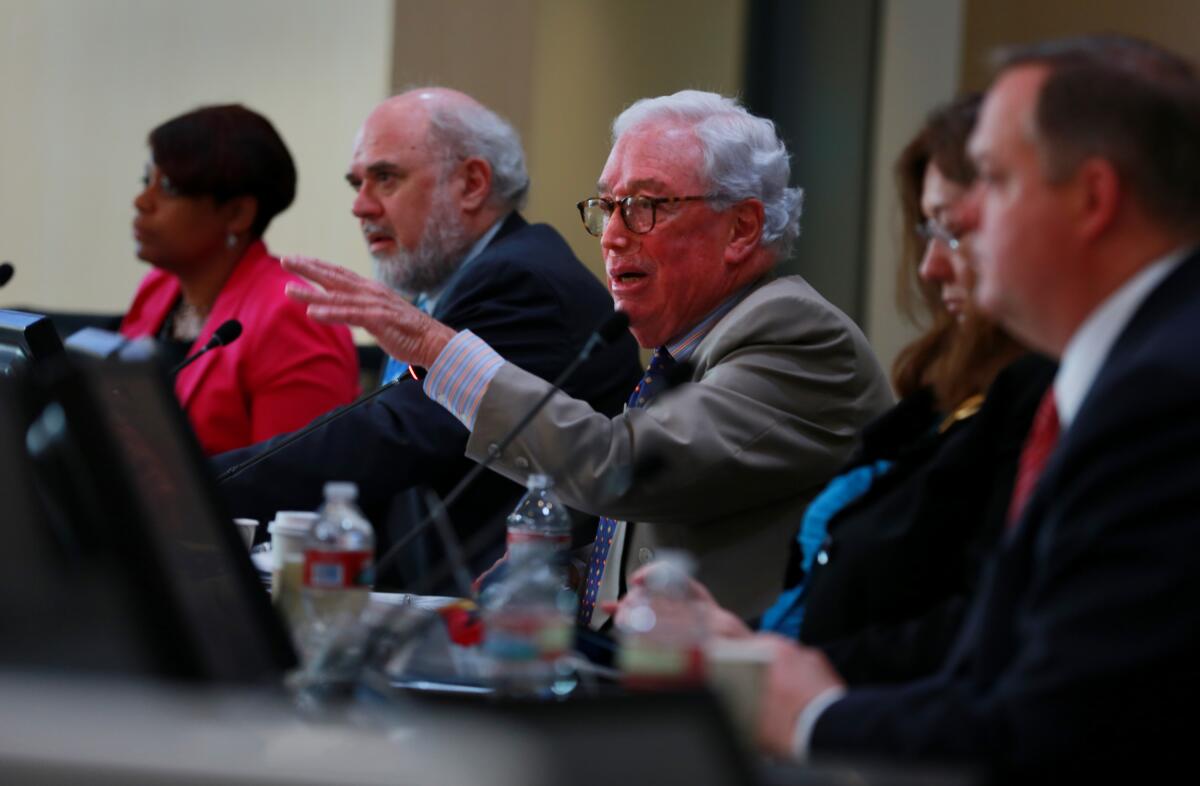The revolving door at public utilities commissions? It’s alive and well

- Share via
This story originally published in Boiling Point, a newsletter about climate change and the environment. Sign up here to get it in your inbox.
If the words “public utilities commission” put you to sleep, you’re not alone.
These are the government agencies that regulate utilities — companies that supply us with electricity, gas, water and more. All 50 states have them — and as boring as they sound, their work affects our daily lives. Utilities commissions have a key role to play in keeping energy bills from getting too high, ensuring the lights stay on and policing bad behavior by monopoly utilities.
They’re also crucial to combating the climate crisis.
Commissioners are responsible for approving large expenditures by utilities, including renewable energy purchases, so they have huge influence over how quickly we stop burning fossil fuels. They also hold sway over rooftop solar incentives, electric vehicle charging stations and how we heat our homes. As the Biden administration begins distributing hundreds of billions of dollars in clean energy funding from the Inflation Reduction Act, commissioners will help determine how that money is spent.
So who are the people making those decisions? And what might their biases look like?
A new study offers a fascinating portrait of America’s utility commissioners — and their industry ties.
Published last week in the peer-reviewed journal Energy Research & Social Science, the study from Brown University postdoctoral researcher Jared Heern examines the professional backgrounds of the 818 utility commissioners who served across all 50 states between 2000 and 2020. Heern found 25% of those commissioners — whose decisions could make or break the planet’s climate — had previously worked in the utility or fossil fuel industry, compared to 19% with an environmental background.
Also striking: Of the 473 commissioners for whom Heern could find information on what they did after they left utility regulation, 50% of them went to work for one of the industries they regulated, or in an industry-adjacent role such as consulting.
“That revolving door is definitely alive and well,” Heern told me.
Alive and well and extremely relevant to the clean energy transition.
Although Heern noted that having previously worked for a utility can give a regulator useful expertise, he also pointed to studies showing that former utility and fossil fuel industry employees who become commissioners “tend to make more decisions that benefit the industry.” That could mean allowing utilities to keep sinking customer money into coal and gas plants when solar or wind would be cheaper. It could also mean slashing incentives for rooftop solar panels, which can threaten utility profits.

Not all utility companies are opposed to climate action — in some cases, far from it.
Take Southern California Edison. The investor-owned utility has emphasized it’s committed to the state’s 100% clean energy target and has pushed for more electric cars on the road and electric heat pumps in homes, to replace gas heating systems.
Of course, reducing demand for oil and natural gas creates more demand for the product Edison sells — electricity.
But some electric utilities have continued to fight aggressive climate action — especially those that have invested heavily in fossil fuels and are counting on customers paying off their investments for years or decades. Those companies are often banking on regulators who see the world their way, according to Leah Stokes, a political scientist at UC Santa Barbara.
“The biggest problem we have with utility regulation in this country is the capture of independent agencies by utilities,” Stokes told me. “Electric rates are higher than they should be. We have way more polluting infrastructure than we need.”
Stokes wasn’t involved with the new study, but she wrote a book about utility industry lobbying, “Short Circuiting Policy: Interest Groups and the Battle Over Clean Energy and Climate Policy in the American States.” She said Heern had compiled a unique and valuable data set that adds to the case for independent utility regulators — building on a study she co-authored last year finding that during the 1990s, electric utilities joined fossil fuel companies in promoting climate denial and doubt.
“Utilities are going to become huge engines of climate action if they can actually wrap their heads around it,” Stokes said.
Heern’s study offered a bit of hope: Twenty-nine percent of utility commissioners in 2020 had a background working on the environment, compared to 12% of commissioners two decades earlier. He speculated that might be because governors — who appoint commissioners in 39 states — have increasingly recognized the importance of climate change in utility regulation.
“If you care about climate — or how much you pay on your electrical bills every month — you should be evaluating governors on what kinds of public utility commissioners they’re going to be appointing,” Heern said.
In California, Gov. Gavin Newsom has made his mark on the Public Utilities Commission, appointing all five members. Two of those members — President Alice Reynolds and Karen Douglas — previously served as Newsom’s senior energy adviser.
That’s common, with 30% of utility commissioners nationwide coming from a governor’s personal network, per Heern’s study.

Newsom’s appointees have faced intense criticism, especially after they voted to reduce rooftop solar incentives at the behest of Edison and other utilities — as well as consumer advocates — who said the payments benefited wealthier families at the expense of poorer ones. Critics have also slammed the agency for allowing the state to remain dependent on gas-fired power plants, and for not moving more aggressively to restructure Pacific Gas & Electric after its electric lines began igniting deadly wildfires.
Newsom’s office didn’t respond to my request for comment about how the governor selects commissioners.
But some of the previous commissioners had close relationships with the utility industry.
Michael Peevey led the Public Utilities Commission for more than a decade, after previously serving as president of SoCal Edison. He stepped down from the commission in 2014 amid allegations of a cozy relationship with PG&E. A few months later, the public learned he had also held secret discussions with Edison, his former employer, to help determine how much money the company’s shareholders would have to pay following the premature closure of the San Onofore nuclear power plant.
Although commissioners are appointed by governors in most places, they’re elected by public vote in nine states.
Elections have pluses and minuses, Heern said. Elected commissioners are less likely to have previously worked in the utility industry, meaning they might be more independent. And they’re more accountable to the public, at least in theory.
On the other hand, elected commissioners tend to have less experience regulating utilities than those appointed by governors — just 26% of elected commissioners have a regulatory background, compared to 45% of appointed commissioners.
And, crucially, utility companies can bankroll elected candidates, exerting influence through campaign cash.
Arizona’s biggest utility, for instance, gave millions of dollars to dark-money groups that helped elect two commissioners — and then refused to acknowledge that spending for years. The new commissioners later voted to slash rooftop solar incentives.
“That may be my biggest concern — that wide-open door for influence by utilities,” Heern said.
New Mexico is another fascinating case study.
In 2020, voters approved a constitutional amendment backed by Gov. Michelle Lujan Grisham that changed the state’s utilities commission from a five-member body elected by voters to a three-member body appointed by the governor.

Almost immediately, things went sideways. One of the governor’s appointees resigned after less than two weeks, acknowledging he did not meet the educational requirements. A few weeks later, another Lujan Grisham appointee, Patrick O’Connell, recused himself from the highest profile decision facing the commission — the proposed acquisition of the state’s largest electric utility by Avangrid, a subsidiary of Spanish energy giant Iberdrola. O’Connell had previously testified in favor of the acquisition.
Even without O’Connell, Iberdrola may get its way. The utilities commission had previously rejected the $8-billion acquisition. But Lujan Grisham supported the deal, and her new commissioners are seeking to reconsider the agency’s earlier decision.
Whether a state elects or appoints utility commissioners, “we can see regulatory capture in either case,” Stokes said.
Lujan Grisham, like Newsom, is a Democrat — which leads to one last point.
Although Heern found that Democratic commissioners were more likely to have an environmental background than Republican commissioners, he otherwise didn’t see much difference between red and blue states, in terms of who is regulating utilities — for better or worse. Governors and appointees of both parties are susceptible to industry influence. There are Democratic governors nominating gas industry executives, and Republican commissioners going along with utility plans for 100% clean energy.
Heern hopes his research sparks further inquiry into how governors select utility regulators, and what factors influence those regulators’ decisions. That information could be valuable for climate advocates working to promote state-level action.
Public utilities commissions “are super important, but they just don’t get any attention,” Heern said.
Hopefully, that will change. Federal scientists reported this week that levels of heat-trapping carbon dioxide in Earth’s atmosphere just reached their highest level in more than 4 million years — and they’re increasing at one of the fastest rates on record.
Public utilities commissions can help stave off catastrophe. But only if we keep the spotlight on them, shining bright.
ONE MORE THING

In the next few weeks, The Times will publish Part 3 of my ongoing series, Repowering the West, exploring how the clean energy transition is reshaping landscapes, ecosystems and communities across the western U.S. This next installment is about Nevada, where renewable energy companies have proposed dozens of large solar farms on public lands surrounding Las Vegas.
Catch up on the first two stories here. And as always, please consider subscribing to The Times to support my reporting.
We’ll be back in your inbox on Tuesday. To view this newsletter in your Web browser, click here. And for more climate and environment news, follow @Sammy_Roth on Twitter.
For the record: Last Tuesday’s edition of this newsletter misstated the headquarters of Southwest Power Pool, a regional transmission organization. It’s based in Arkansas.
Toward a more sustainable California
Get Boiling Point, our newsletter exploring climate change, energy and the environment, and become part of the conversation — and the solution.
You may occasionally receive promotional content from the Los Angeles Times.




